de Havilland Aircraft Museum
The de Havilland Aircraft Museum, formerly the de Havilland Aircraft Heritage Centre, is a volunteer-run aviation museum in London Colney, Hertfordshire, England.[1] The collection is built around the definitive prototype and restoration shops for the de Havilland Mosquito and also includes several examples of the de Havilland Vampire – the third operational jet aircraft in the world. The museum is the largest such museum devoted to one manufacturer in the country.
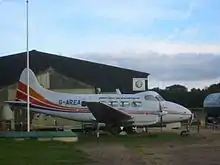 | |
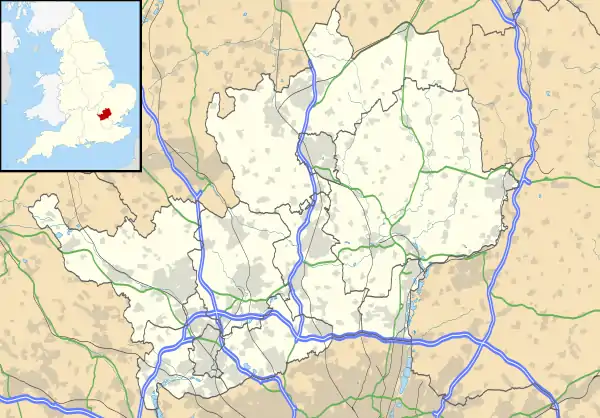 Location within Hertfordshire | |
Former name |
|
|---|---|
| Established | 1959 |
| Location | London Colney, Hertfordshire, UK |
| Coordinates | 51.710833°N 0.271111°W |
| Type | Aviation museum |
| Website | dehavillandmuseum.co.uk |
History
Salisbury Hall

The site has been occupied by a number of large manor houses since the 9th Century. The present house was built around 1668 by the London banker James Hoare, bringing with it associations with Charles II and Nell Gwynne, who lived in a cottage by the bridge to the Hall. The Hall subsequently passed through various hands, and during the latter part of the 19th century was occupied by a succession of farmers. However, about 1905 Lady Randolph Churchill, as Mrs. Cornwallis West, came here to live. Her son, Winston Churchill, became a regular visitor.
During the 1930s, Sir Nigel Gresley, of the London and North Eastern Railway, was in residence. He was responsible for the A4 Pacific steam locomotives, one of which, Mallard, still holds the world speed record for steam locomotives of 126 mph (203 km/h). It is believed that the locomotive was named after the ducks in the moat.
In September 1939, the de Havilland Aircraft Company established the Mosquito design team in the Hall, the prototype Mosquito, E0234/W4050, subsequently being built in the adjacent buildings. Nell Gwynne's cottage, meanwhile, was the centre of a silk worm farm, which supplied the silk for the Queen's wedding and Coronation robes. After de Havilland left in 1947 the Hall slipped into a derelict condition.[2]
When Walter Goldsmith, a retired army major, purchased Salisbury Hall, he soon came to realise that it had been used by de Havilland during the war. On contacting Bill Baird, then in charge of PR at de Havilland at Hatfield, he discovered that the company had used it as the design centre for the Mosquito, and that Baird had squirrelled the original prototype away in the Fiddlebridge stores, just off the airfield at Hatfield. Having resisted several calls to burn the aircraft, Baird was delighted to find someone who could offer the old aircraft a home. de Havilland carried out basic restoration work at Hatfield, and Goldsmith accepted the aircraft back at Salisbury Hall in 1959.
Prototype Mosquito
The prototype Mosquito became the first aircraft to be displayed at Salisbury Hall, and was followed by examples of the de Havilland Vampire and Venom in 1968. In 1970, the collection was joined by a further example of the de Havilland Mosquito, which had been donated by Liverpool Corporation, following its use in the film Mosquito Squadron.[3]
The collection was later expanded, with examples of the single-seat Vampire, Sea Venom, Sea Vixen, Chipmunk and Dove all arriving by 1978. Additionally, the fuselage of a Mosquito FB6 arrived in 1976; it is now the only survivor of the most numerous sub-type to be preserved in Europe. The museum houses the fuselage of the last surviving square-windowed de Havilland Comet 1, the world's first jet airliner.
Later history
The supporters' society has been responsible for the restoration and conservation of many of the exhibits, starting with the Chipmunk in 1978, an airframe which was subsequently restored by members once more between 2003 and 2007. The supporters were also active in building a hangar to house the ex-Liverpool Mosquito in 1980, and then completely restoring the aircraft, a task they completed in 1990. The supporters' society has also been responsible for work on a Tiger Moth, Hornet Moth, Mosquito 6, Heron, Dove, several Vampires and many other aircraft in the collection.
In 2001, it was recognised that the prototype Mosquito was in dire need of conservation work. This work is ongoing, and is supported by BAE Systems.[4]
The museum opened the new Sir Geoffrey de Havilland Hangar in February 2020.[5][6]
Collection
Aircraft on display
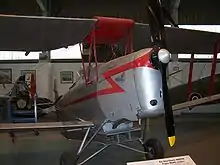
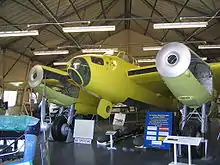
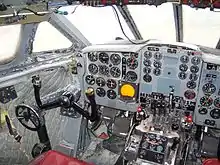
- Airspeed Horsa I/II BAPC.232 – Composite fuselage[7]
- British Aerospace 146-100 G-JEAO – Fuselage only[8]
- Cierva C.24 G-ABLM – On permanent loan from the Science Museum[9]
- de Havilland DH.53 Humming Bird J7326 – Fuselage only[10]
- de Havilland DH.82 Tiger Moth G-ANRX[11]
- de Havilland DH.82 Queen Bee LF789 – Fuselage only[12]
- de Havilland DH.87 Hornet Moth G-ADOT[13]
- de Havilland DH.88 Comet G-ACSS – Replica[14]
- de Havilland DH.98 Mosquito FB.VI TA122/TW233[15]
- de Havilland DH.98 Mosquito TT(B)35 TA634[16]
- de Havilland DH.100 Vampire FB.6 J-1008[17]
- de Havilland DH.103 Hornet VX250 – Tail section[18]
- de Havilland DH.104 Dove 8 G-AREA[19]
- de Havilland DH.106 Comet 1A F-BGNX – Fuselage only[20]
- de Havilland DH.106 Comet 1A G-ANAV – Nose section[21]
- de Havilland DH.106 Comet C.2(R) XK695 – Cockpit section[22]
- de Havilland DH.106 Comet 2 – Nose section[23]
- de Havilland DH.110 Sea Vixen FAW.2 XJ565[24]
- de Havilland DH.114 Heron G-AOTI[25]
- de Havilland DH.115 Vampire T.11 XJ772[26]
- de Havilland DH.125 Series 1 G-ARYC[27]
- de Havilland Canada DHC-1 Chipmunk T.10 WP790[28]
- Hawker Siddeley HS.121 Trident 2E G-AVFH[29]
Aircraft in storage
- de Havilland DH.98 Mosquito TT.35 TJ118 – Fuselage, with nose section removed.
- de Havilland DH.100 Vampire FB.5 VV217[30]
- de Havilland DH.104 Dove 6 D-IFSB – On loan to ARG Fishburn
- de Havilland DH.112 Venom FB.4 WR539[31]
- de Havilland DH.112 Venom FB.50 J-1632
- de Havilland DH.112 Venom FB.54 J-1790
- de Havilland DH.112 Venom NF.3 WX853[32]
- de Havilland DH.113 Vampire NF.10 WM729 – fuselage pod only[33]
- de Havilland DH.125 Jet Dragon G-ARYA – Cockpit section only
Aircraft under restoration
- de Havilland DH.89A Dragon Rapide G-AKDW[34]
- de Havilland DH.98 Mosquito I W4050[35]
- de Havilland DH.112 Sea Venom FAW.22 XG730[36]
Engines on display
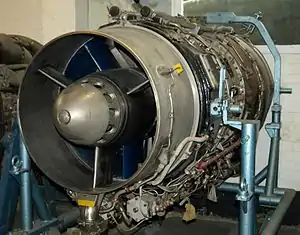
- Piston engines
- Gas turbine engines
- Rocket engines
See also
- List of aerospace museums
References
Notes
- Ellis 2004, p.79.
- "de Havilland Aircraft Heritage Centre - incorporating the Mosquito Aircraft Museum". Culture 24. Retrieved 22 September 2020.
- Birtles, Philip (January 2016). "MUSEUM HISTORY". de Havilland Aircraft Museum. Retrieved 22 September 2020.
- Ellis 2004, p.80.
- "NEW HANGAR PROJECT". de Havilland Aircraft Museum. Retrieved 22 September 2020.
- Davies, Alan (16 February 2020). "What to see at new-look de Havilland Aircraft Museum". Welwyn Hatfield Times. Retrieved 22 September 2020.
- "AIRSPEED AS.51 & 58 HORSA GLIDER". de Havilland Aircraft Museum. Retrieved 21 September 2020.
- "BRITISH AEROSPACE BAE 146-100". de Havilland Aircraft Museum. Retrieved 21 September 2020.
- "DE HAVILLAND CIERVA C.24 AUTOGIRO". de Havilland Aircraft Museum. Retrieved 21 September 2020.
- "DE HAVILLAND DH53 HUMMING BIRD". de Havilland Aircraft Museum. Retrieved 21 September 2020.
- "DE HAVILLAND DH82A TIGER MOTH". de Havilland Aircraft Museum. Retrieved 21 September 2020.
- "DE HAVILLAND DH82B QUEEN BEE". de Havilland Aircraft Museum. Retrieved 21 September 2020.
- "DE HAVILLAND DH87B HORNET MOTH". de Havilland Aircraft Museum. Retrieved 21 September 2020.
- "DE HAVILLAND DH88 COMET RACER". de Havilland Aircraft Museum. Retrieved 21 September 2020.
- "DE HAVILLAND DH98 MOSQUITO FB MK.VI". de Havilland Aircraft Museum. Retrieved 21 September 2020.
- "DE HAVILLAND DH98 MOSQUITO B.MK.35". de Havilland Aircraft Museum. Retrieved 21 September 2020.
- "DE HAVILLAND DH100 VAMPIRE FB.6". de Havilland Aircraft Museum. Retrieved 21 September 2020.
- "DE HAVILLAND DH103 SEA HORNET NF.21 (TAIL SECTION)". de Havilland Aircraft Museum. Retrieved 21 September 2020.
- "DE HAVILLAND DH104 DOVE MK.8". de Havilland Aircraft Museum. Retrieved 21 September 2020.
- "DE HAVILLAND DH106 COMET 1A". de Havilland Aircraft Museum. Retrieved 21 September 2020.
- "COMET G-ANAV FOR MAGS". de Havilland Aircraft Museum. 6 May 2016. Retrieved 21 September 2020.
- "DE HAVILLAND DH106 COMET 2R". de Havilland Aircraft Museum. Retrieved 21 September 2020.
- "DE HAVILLAND DH106 COMET 4". de Havilland Aircraft Museum. Retrieved 21 September 2020.
- "DE HAVILLAND DH110 SEA VIXEN FAW.2". de Havilland Aircraft Museum. Retrieved 21 September 2020.
- "DE HAVILLAND DH114 HERON MK.2D". de Havilland Aircraft Museum. Retrieved 21 September 2020.
- "DE HAVILLAND DH115 VAMPIRE T.11". de Havilland Aircraft Museum. Retrieved 21 September 2020.
- "DE HAVILLAND DH125". de Havilland Aircraft Museum. Retrieved 21 September 2020.
- "DE HAVILLAND DHC1 CHIPMUNK T.MK.10". de Havilland Aircraft Museum. Retrieved 21 September 2020.
- "DE HAVILLAND DH121 TRIDENT". de Havilland Aircraft Museum. Retrieved 21 September 2020.
- "DE HAVILLAND DH 100 VAMPIRE FB5 VV217". de Havilland Aircraft Museum. Retrieved 21 September 2020.
- "DE HAVILLAND DH112 VENOM FB.4". de Havilland Aircraft Museum. Retrieved 21 September 2020.
- "DE HAVILLAND DH112 VENOM NF.3". de Havilland Aircraft Museum. Retrieved 21 September 2020.
- "DE HAVILLAND DH113 VAMPIRE NF10". de Havilland Aircraft Museum. Retrieved 21 September 2020.
- "DE HAVILLAND DH89A DRAGON RAPIDE". de Havilland Aircraft Museum. Retrieved 21 September 2020.
- "DE HAVILLAND DH98 MOSQUITO PROTOTYPE". de Havilland Aircraft Museum. Retrieved 21 September 2020.
- "DE HAVILLAND DH112 SEA VENOM FAW.22". de Havilland Aircraft Museum. Retrieved 21 September 2020.
- "DE HAVILLAND GIPSY III". de Havilland Aircraft Museum. Retrieved 21 September 2020.
- "DE HAVILLAND GIPSY MAJOR". de Havilland Aircraft Museum. Retrieved 21 September 2020.
- "DE HAVILLAND GIPSY QUEEN 30". de Havilland Aircraft Museum. Retrieved 21 September 2020.
- "DE HAVILLAND GIPSY TWELVE". de Havilland Aircraft Museum. Retrieved 21 September 2020.
- "DE HAVILLAND GHOST MK. 104". de Havilland Aircraft Museum. Retrieved 21 September 2020.
- "DE HAVILLAND GOBLIN 35". de Havilland Aircraft Museum. Retrieved 21 September 2020.
- "DE HAVILLAND GYRON". de Havilland Aircraft Museum. Retrieved 21 September 2020.
- "DE HAVILLAND GYRON JUNIOR". de Havilland Aircraft Museum. Retrieved 21 September 2020.
- "DE HAVILLAND GNOME". de Havilland Aircraft Museum. Retrieved 21 September 2020.
- "DE HAVILLAND SUPER SPRITE". de Havilland Aircraft Museum. Retrieved 21 September 2020.
- "DE HAVILLAND SPECTRE ROCKET". de Havilland Aircraft Museum. Retrieved 21 September 2020.
Bibliography
- Ellis, Ken. Wrecks and Relics - 19th Edition, Midland Publishing, Hinckley, Leicestershire. 2004. ISBN 1-85780-183-0
External links
| Wikimedia Commons has media related to De Havilland Aircraft Heritage Centre. |